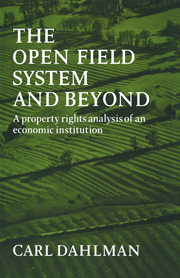Book contents
- Frontmatter
- Contents
- Preface
- 1 Introduction
- 2 Theories of the open field system
- 3 Property rights, transaction costs, and institutions
- 4 The economics of commons, open fields, and scattered strips
- 5 The economics of enclosure
- 6 Some extensions and generalizations
- Bibliography
- Index of names
- Index of subjects
5 - The economics of enclosure
Published online by Cambridge University Press: 07 October 2011
- Frontmatter
- Contents
- Preface
- 1 Introduction
- 2 Theories of the open field system
- 3 Property rights, transaction costs, and institutions
- 4 The economics of commons, open fields, and scattered strips
- 5 The economics of enclosure
- 6 Some extensions and generalizations
- Bibliography
- Index of names
- Index of subjects
Summary
In the previous chapter we presented a theory of the scattered strips and the open fields. Throughout, we have stressed the fact that any theory of a particular institutional organization that attempts to construct an explanation in terms of economic efficiency cannot be considered satisfactory unless it is also consistent with those factors that made that organization undesirable, so that it was eventually replaced by another one. With respect to the open fields there is a remarkably clear-cut series of events that marked the end of the system – the enclosure of open fields. Clearly, the previous attempt at a theoretical construction will amount to nothing but a tedious game, unless it can be shown that this particular approach is also consistent with the known facts of the enclosure movements.
Our explanation of enclosures may therefore also be regarded as an attempt at an empirical test of our hypothesis about the nature of the open field system. As such, it will be no more than an initial step; we do not attempt a full-scale statistical investigation. The aim will be set at a comparatively low level, as judged against the standards of the modern cliometric school. It will suffice to resort to another set of ‘stylized facts’, in this case those features of the enclosure movements that are accorded a fairly broad consensus among the specialized historians of the primary source material and the local history of enclosure.
- Type
- Chapter
- Information
- The Open Field System and BeyondA property rights analysis of an economic institution, pp. 146 - 199Publisher: Cambridge University PressPrint publication year: 1980



